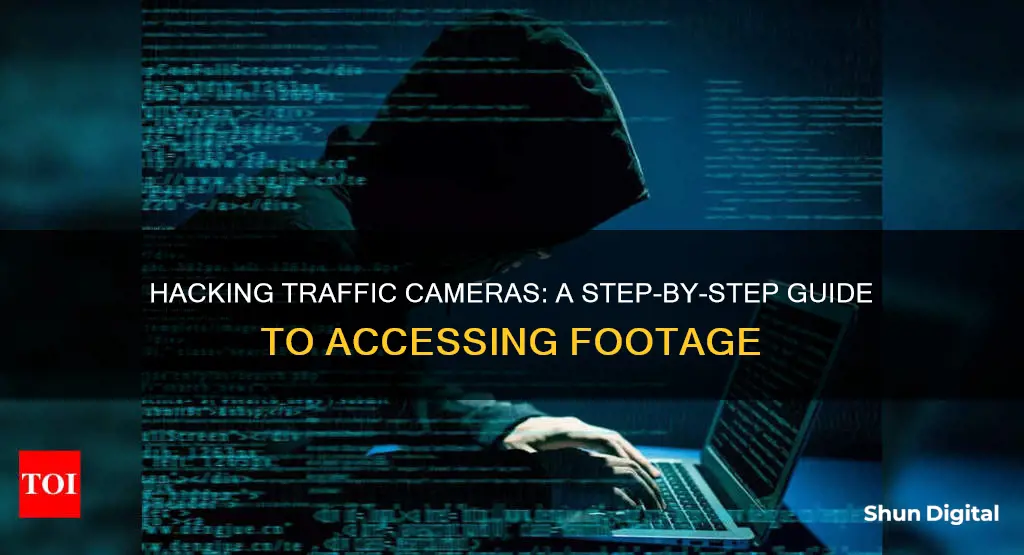
Traffic cameras are an essential tool for monitoring and managing road safety, but they can also be vulnerable to hacking attempts. While hacking a traffic camera may seem like a complex and illegal task, understanding the potential risks and methods can help improve security measures. In this article, we will explore the various ways through which traffic cameras can be hacked, the ethical implications, and the steps needed to protect these devices from unauthorized access. By examining real-world examples and expert insights, we can gain valuable knowledge to secure our traffic cameras and prevent malicious activities.
| Characteristics | Values |
|---|---|
| Difficulty | Hacking traffic cameras can be alarmingly simple |
| Methods | Using default passwords, brute force attacks, SQL injection, intercepting security camera footage, using exploit tools, using search engines, jamming or disrupting signals |
| Tools | Angry IP Scanner, Shodan, Hydra, Wireshark, CCTV testers, routersploit, Airgraph-ng, Deauther Watch, Sonic |
| Targets | IoT devices, wireless security cameras, CCTV cameras, speed cameras, baby monitors, smart doorbells |
| Prevention | Changing default passwords, blocking outbound traffic to UDP port 32100, disabling peer-to-peer features |
What You'll Learn

Use a website that shows hacked traffic cameras
Using a website that shows hacked traffic cameras is an easy way to access live footage from traffic cameras worldwide. One of the most prominent websites in this regard is insecam.org, which offers a vast catalogue of unsecured cameras, including traffic cameras, that anyone can access. The website randomly tries default usernames and passwords for security cameras, and if successful, adds them to its live online list. This simple method has allowed insecam.org to list over 100,000 cameras from people's homes across the globe.
Another similar website is Opentopia, which also lists hundreds of unsecured cameras worldwide. Opentopia provides additional features such as the ability to select cameras by city or country, view still images and gifs of the last feed, and create an account to leave comments.
While these websites provide easy access to hacked traffic cameras, it is important to note that the practice of viewing unsecured cameras without permission raises serious privacy and ethical concerns.
Long Beach Camera Tickets: What You Need to Know
You may want to see also

Hack traffic cameras using default passwords
Hacking traffic cameras using default passwords is a relatively simple process, but it requires some technical knowledge. Here is a step-by-step guide on how to do it:
Step 1: Find the IP Camera Online
Locate the IP camera that you want to hack. You can use a network IP scanner like Angry IP Scanner to scan the Internet and look for IP cameras within a specific IP address range. This tool will help you find the IP address and port number of the camera you want to target.
Step 2: Install and Configure Angry IP Scanner
Download and install Angry IP Scanner on your computer. Configure the scanner by setting the ports to 80, 23, 8080, 8081, and 8082, as these are the most commonly used ports for IP cameras. Additionally, configure the fetchers to display Web Detect information, which will help identify the manufacturer of the camera.
Step 3: Find the Default Password
Once you have the IP address and port number of the camera, search for the default username and password for that specific camera model. You can usually find this information in the camera's manual or by searching online. Default passwords are often easily accessible online, and many devices still use the original password set by the manufacturer.
Step 4: Attempt to Login
Now that you have the IP address, port number, and default login credentials, try to access the camera's control interface by entering the default username and password. If the default password has not been changed, you should be able to gain access to the camera.
Step 5: Be Cautious and Responsible
Hacking into someone else's traffic camera without authorization is illegal and unethical. This guide is for educational purposes only, and you should not attempt to hack any camera without the owner's explicit consent. Always respect people's privacy and use this knowledge to enhance your security measures rather than for malicious purposes.
Office Depot's Surveillance Camera Options: What You Need to Know
You may want to see also

Hack traffic cameras using Shodan
Shodan is a search engine that works similarly to Google, but instead of generic searches, it looks for devices connected to the internet. It was created by John Matherly, who initially crawled the web for randomly generated IP addresses and eventually developed a search engine to search through his growing database of internet-connected devices.
Shodan works by requesting connections to every possible IP address on the internet and indexing the information that it gets back from those connection requests. It "knocks" at every possible port of every possible IP address, all day, every day. When a port is set to "open", Shodan can establish a connection and the device sends a packet of information called a "banner" that contains metadata about the device.
Some devices include their default login and password, make and model, and software version, which can all be exploited by hackers. Shodan has been used to gain access to webcams, automated greenhouse watering systems, traffic light systems, and school management information systems.
To use Shodan, you can either go to its website or use its command-line interface. To use the latter, you first need to install the Shodan library with a working Python installation. Then, you can use the `shodan` command in a terminal window to perform searches.
- Search by the manufacturer or model of the camera. For example, if you wanted to search for cameras made by "WebcamXP", you could type `webcamxp` into the search engine.
- Search by geographical location. For example, to find WebcamXP cameras in Australia, you could type `webcamxp country:AU`. To narrow it down further, you could search by city, e.g. `webcamxp city:sydney`.
- Search by longitude and latitude. For example, to find WebcamXP cameras in Melbourne, Australia, you could search for `webcamxp geo:-37.81,144.96`.
Once you've found a traffic camera that you're interested in, you can try accessing it by entering its domain name into a web browser. If it requires authentication, you could try using the default username and password for the camera.
While Shodan can be used to find and potentially exploit vulnerable traffic cameras, it's important to note that Shodan itself is not a hacking tool. It simply indexes publicly available information.
Infinity Focus: How to Check Your Camera's Focus
You may want to see also

Hack traffic cameras using an exploit tool (software)
Hacking traffic cameras is illegal and unethical and should not be done under any circumstances. This response is for educational purposes only.
Hack CCTV Camera Using an Exploit Tool (Software)
When an IP device has some security problem, hackers can create exploit tools to automate the hacking process. That happens also with IP cameras.
In March 2017, a security flaw was discovered in Hikvision IP cameras that allowed direct access to device information such as the model, serial number, firmware version, and users. The company released a fix for the problem five days after the problem was reported, but cameras that are using the old firmware will still be vulnerable to this security flaw.
The Hikvision IP camera exploit tool is very easy to use. You just need to run it on a computer or laptop to explore and hack CCTV cameras that are online on the Internet or in your local network.
To use the software, follow these steps:
- Type the camera IP and port
- Click "get user list"
- Select the user to change the password
- Type a new password and click the button
After following these steps, you just need to type the camera IP and port on a Web Browser and log in by using the credential you just created.
Cameras that are affected by the security vulnerability include the Hikvision DS-2CD2420F-IW model. If you have one of them, just upgrade the firmware to correct the problem so you don't have your CCTV camera hacked.
Surveillance Cameras: Live Viewing and Remote Monitoring
You may want to see also

Hack traffic cameras using a simple command
Hacking traffic cameras can be done in many ways, some of which are easy, while others are more technical. One method involves using a simple command to extract information from the camera. Here's a step-by-step guide on how to do it:
Step 1: Find the Camera's IP Address
Locate the IP address of the traffic camera you want to hack. This can be done using an IP scanner tool like Angry IP Scanner, which can detect devices connected to your network.
Step 2: Install and Configure Angry IP Scanner
Download and install Angry IP Scanner, which is available for Windows, Mac, and Linux. Configure the scanner by setting the ports to 80, 23, 8080, 8081, and 8082, as these are commonly used by IP cameras.
Step 3: Scan for the Camera's IP Address
Using Angry IP Scanner, choose an IP address range to scan. This range can be based on your country or service provider. Scanning a wider range increases the chances of finding the target camera.
Step 4: Identify the Camera Manufacturer and Model
Once you've found the camera's IP address, open it in a web browser. This will typically bring up a login screen. Identify the manufacturer and model of the camera, which will be useful for the next steps.
Step 5: Find Default Passwords
Search online for default usernames and passwords for the specific camera model you are targeting. Many devices still use the default credentials set by the manufacturer, making this a common and effective hacking technique.
Step 6: Attempt to Login
Using the default credentials you found, try to log in to the camera's control interface. If the default password hasn't been changed, you should now have access to the camera.
Step 7: Extract Information
Now that you have access, you can extract information from the camera. This may include device details, such as the model, serial number, firmware version, and user list. You may also be able to take a screenshot or view live footage, depending on the camera's functionality.
It's important to note that hacking traffic cameras without authorization is illegal and unethical. This information is provided for educational purposes only, and you should not attempt to hack any camera without the owner's consent.
Traffic Cameras in Colorado Springs: Are They Watching?
You may want to see also
Frequently asked questions
Yes, it is possible to hack traffic cameras, but it is important to note that doing so without authorization is illegal. Hacking traffic cameras can compromise people's privacy and security, so it is crucial to only attempt this on cameras that you own or have permission to test.
There are various tools and techniques available for hacking traffic cameras. Some common methods include using default passwords, exploiting software vulnerabilities, brute-force attacks, and intercepting network traffic. It is also possible to use specific software and tools like Angry IP Scanner, Shodan, or Hydra to scan for and exploit vulnerabilities in traffic cameras.
You can use online resources and tools such as Shodan or Angry IP Scanner to scan for and locate traffic cameras that are connected to the internet. These tools allow you to search by IP address ranges, manufacturers, or countries to find potential targets.
When attempting to hack a traffic camera, it is essential to take precautions to avoid detection. This includes using a secure connection, such as a VPN, to mask your location and identity. Additionally, regularly checking for and installing any available firmware updates on the camera can help patch known vulnerabilities that hackers might exploit.







